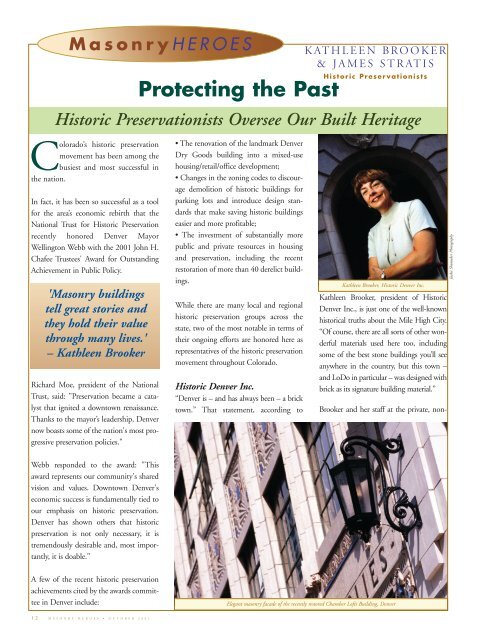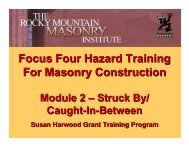Masonry Heroes final
Masonry Heroes final
Masonry Heroes final
Create successful ePaper yourself
Turn your PDF publications into a flip-book with our unique Google optimized e-Paper software.
Historic Preservationists Oversee Our Built Heritage<br />
Colorado’s historic preservation<br />
movement has been among the<br />
busiest and most successful in<br />
the nation.<br />
In fact, it has been so successful as a tool<br />
for the area’s economic rebirth that the<br />
National Trust for Historic Preservation<br />
recently honored Denver Mayor<br />
Wellington Webb with the 2001 John H.<br />
Chafee Trustees' Award for Outstanding<br />
Achievement in Public Policy.<br />
'<strong>Masonry</strong> buildings<br />
tell great stories and<br />
they hold their value<br />
through many lives.'<br />
– Kathleen Brooker<br />
Richard Moe, president of the National<br />
Trust, said: "Preservation became a catalyst<br />
that ignited a downtown renaissance.<br />
Thanks to the mayor’s leadership, Denver<br />
now boasts some of the nation's most progressive<br />
preservation policies."<br />
Webb responded to the award: "This<br />
award represents our community's shared<br />
vision and values. Downtown Denver's<br />
economic success is fundamentally tied to<br />
our emphasis on historic preservation.<br />
Denver has shown others that historic<br />
preservation is not only necessary, it is<br />
tremendously desirable and, most importantly,<br />
it is doable."<br />
A few of the recent historic preservation<br />
achievements cited by the awards committee<br />
in Denver include:<br />
12 MASONRY HEROES • OCTOBER 2001<br />
Protecting the Past<br />
• The renovation of the landmark Denver<br />
Dry Goods building into a mixed-use<br />
housing/retail/office development;<br />
• Changes in the zoning codes to discourage<br />
demolition of historic buildings for<br />
parking lots and introduce design standards<br />
that make saving historic buildings<br />
easier and more profitable;<br />
• The investment of substantially more<br />
public and private resources in housing<br />
and preservation, including the recent<br />
restoration of more than 40 derelict buildings.<br />
While there are many local and regional<br />
historic preservation groups across the<br />
state, two of the most notable in terms of<br />
their ongoing efforts are honored here as<br />
representatives of the historic preservation<br />
movement throughout Colorado.<br />
Historic Denver Inc.<br />
“Denver is – and has always been – a brick<br />
town.” That statement, according to<br />
KATHLEEN BROOKER<br />
& JAMES STRATIS<br />
Historic Preservationists<br />
Kathleen Brooker, Historic Denver Inc.<br />
Kathleen Brooker, president of Historic<br />
Denver Inc., is just one of the well-known<br />
historical truths about the Mile High City.<br />
“Of course, there are all sorts of other wonderful<br />
materials used here too, including<br />
some of the best stone buildings you’ll see<br />
anywhere in the country, but this town –<br />
and LoDo in particular – was designed with<br />
brick as its signature building material.”<br />
Brooker and her staff at the private, non-<br />
Elegant masonry facade of the recently restored Chamber Lofts Building, Denver<br />
Jackie Shumaker Photography
profit Historic Denver write grants and<br />
work in partnership with the private owners<br />
of older buildings to establish a preservation<br />
plan for them. First, the sites must<br />
be nationally registered and locally recognized<br />
historic properties. Then Historic<br />
Denver establishes a perpetual easement<br />
where the owner agrees to give up the right<br />
to demolish the building, makes a cash<br />
donation to help with repairs and allows<br />
Historic Denver to oversee its maintenance.<br />
This system becomes “the ultimate preservation<br />
tool,” according to Brooker.<br />
Historic Denver has also been successful<br />
KATHLEEN BROOKER & JAMES STRATIS<br />
The historic Hardware Block in Denver’s LoDo neighborhood<br />
in creating a national historic district for<br />
the downtown area. In Denver, that is the<br />
only way to permanently save older buildings<br />
from demolition, since a local historic<br />
designation protects them for only a year<br />
at a time. Representatives of Historic<br />
Denver met with each property owner in<br />
the area and asked them to participate in<br />
the district by offering tax breaks and<br />
incentives in exchange for their support.<br />
Another part of Historic Denver’s focus is<br />
on the city’s neighborhoods, sustaining<br />
and expanding its 38 historic districts.<br />
Part of the goal is to stop the demolition<br />
Historic Denver Inc.<br />
and replacement of older homes with<br />
what Brooker calls “the long houses” – the<br />
“fake stucco monsters” that stretch from<br />
sidewalk to alley and ruin the character of<br />
a block. That includes special attention to<br />
preserving older masonry homes since<br />
“they define the character of a neighborhood,”<br />
Brooker said.<br />
Brooker’s work at Historic Denver culminates<br />
her life-long love affair with beautiful<br />
old buildings and masonry. She gladly<br />
offers the reasons why preservation of<br />
masonry structures is so important to<br />
what she does: “It’s the way that brick<br />
MASONRY HEROES • OCTOBER 2001 13<br />
Jackie Shumaker Photography
Jackie Shumaker Photography<br />
The Colorado Historical Society<br />
catches the light and reflects it back, especially<br />
at twilight. Nothing else soothes<br />
light quite that way. Then there’s the beauty<br />
and value of masonry buildings. They<br />
tell great stories, and they hold their value<br />
through many lives. We try to preserve<br />
those stories for everyone.”<br />
The Colorado Historical Society<br />
James Stratis makes no bones about it:<br />
“Preservation is maintenance and maintenance<br />
is preservation.”<br />
Along with his colleagues, Stratis – projects<br />
manager for the Colorado Historical<br />
Society – works to ensure that grant fund-<br />
James Stratis, Colorado Historical Society<br />
ing for the state’s preservation projects gets<br />
into the right hands for the right reasons.<br />
As much as building owners and architects<br />
appreciate the technical expertise offered by<br />
Stratis and the Society’s other historic<br />
preservationists, they also respect its financial<br />
clout.<br />
The Colorado Historical Society receives<br />
100 percent of its funding from the state’s<br />
gaming taxes, around $20 million a year.<br />
From that, they distribute grants twice a<br />
year to projects across the state, with recent<br />
averages of around $100,000 per award.<br />
“Because we hand out the grants, we can<br />
increase both the quality of maintenance<br />
14 MASONRY HEROES • OCTOBER 2001<br />
KATHLEEN BROOKER & JAMES STRATIS<br />
Denver’s REI Flagship Store – A model of preservation and adaptive reuse<br />
and the awareness of how to work with<br />
masonry and other materials in rehabilitation<br />
projects,” Stratis said. “We oversee a<br />
lot of masonry buildings. That’s a big part<br />
of our jobs – understanding how to preserve<br />
different masonry types, and that<br />
can get very technical. The only times<br />
we’ve failed is when we didn’t require that<br />
technical attention to historic detail and<br />
maintenance.”<br />
<strong>Masonry</strong> preservation and maintenance<br />
requirements are often speced into the<br />
grants themselves, which requires the close<br />
cooperation of area masons. “We often<br />
collaborate with the local masonry firms.<br />
We need their expertise because they are<br />
out there every day working with the<br />
materials, and they help us decide what<br />
can and can’t be done in some projects.”<br />
'We often collaborate<br />
with local masonry<br />
firms. We need their<br />
expertise.'<br />
– James Stratis<br />
Stratis counts among the Society’s recent<br />
masonry preservation successes the rehabilitation<br />
and reuse at the REI building<br />
along the South Platte River, the Denver<br />
Jackie Shumaker Photography
Jackie Shumaker Photography<br />
KATHLEEN BROOKER & JAMES STRATIS<br />
Brick detail from the Apple Plumbing Center at 6th and Broadway<br />
The Colorado Historical Society<br />
Dry Goods building, the Wynkoop<br />
Brewery, the Tattered Cover Bookstore in<br />
LoDo and the William Fisher Mansion at<br />
1600 Logan St., now the offices of David<br />
Owen Tryba Architects.<br />
On those projects, the Colorado Historical<br />
Society provided technical assistance, regular<br />
project reviews and worked closely with<br />
sponsoring agencies like the Denver Urban<br />
Renewal Authority and others to facilitate<br />
their completion.<br />
“We look at the smallest details and the<br />
bigger preservation picture at the same<br />
time,” Stratis said. “Our priorities are to<br />
create the longest life-cycle of preservation<br />
possible and the most cost-efficient maintenance<br />
plans for our buildings. We want<br />
people to keep coming to us for help and<br />
bringing us their expertise as well. That’s<br />
when it works like it should.” ◆<br />
MASONRY HEROES • OCTOBER 2001 15



